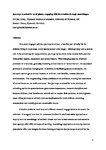Journeys to school in rural places: Engaging with the troubles through assemblages
| dc.contributor.author | Gristy, Cath | |
| dc.date.accessioned | 2019-11-03T15:20:47Z | |
| dc.date.available | 2019-11-03T15:20:47Z | |
| dc.date.issued | 2019-10-15 | |
| dc.identifier.issn | 0743-0167 | |
| dc.identifier.uri | http://hdl.handle.net/10026.1/15107 | |
| dc.description.abstract |
This paper engages with bus journeys to school, a familiar part of daily life for children living in rural areas, where journeys tend to be longer. Although they have a central role in the school day for many children, journeys by bus from home receive little attention from policy makers, researchers and school leaders. With changing patterns of school provision in rural areas, generally involving school closure or ‘consolidation’, the associated journeys to school are changing too. In addition to facilitating access to education, the transport used to get to school impacts on children, their families, communities and environments. The longstanding, knotty problems of the provision, running and experience of school buses are not well understood. Bus journeys to school lie in the shadows of schooling and in the spaces between government departments, research disciplines and between children, their families and schools and so receive little attention. In this neglected space of bus journeys to school, there are implications for rural children, schooling, communities and socially just and sustainable futures. Complex problems need new and different research engagements in the search for solutions. It is argued here that the processes involved in vital materialist approaches to enquiry such as assemblage, where both human and non-human actants are understood to have agency, offer different ways of working. Assemblage approaches to enquiry have the potential to offer new insights for those looking to improve bus journeys to school for the wellbeing of children and the planet as they offer an opportunity for producing knowledge differently. The paper presents a worked example of the use of an assemblage approach to a rural community case study. It is argued that an assemblage approach to the enquiry, offered a process with which to surface and work on a key emerging issue for the young people in the case study; that of their bus journeys to school. | |
| dc.format.extent | 286-292 | |
| dc.language | en | |
| dc.language.iso | en | |
| dc.publisher | Elsevier | |
| dc.subject | School | |
| dc.subject | Bus | |
| dc.subject | Journeys | |
| dc.subject | Assemblages | |
| dc.title | Journeys to school in rural places: Engaging with the troubles through assemblages | |
| dc.type | journal-article | |
| dc.type | Journal Article | |
| plymouth.author-url | https://www.webofscience.com/api/gateway?GWVersion=2&SrcApp=PARTNER_APP&SrcAuth=LinksAMR&KeyUT=WOS:000498293300026&DestLinkType=FullRecord&DestApp=ALL_WOS&UsrCustomerID=11bb513d99f797142bcfeffcc58ea008 | |
| plymouth.volume | 72 | |
| plymouth.publication-status | Published | |
| plymouth.journal | Journal of Rural Studies | |
| dc.identifier.doi | 10.1016/j.jrurstud.2019.10.016 | |
| plymouth.organisational-group | /Plymouth | |
| plymouth.organisational-group | /Plymouth/Faculty of Arts, Humanities and Business | |
| plymouth.organisational-group | /Plymouth/Faculty of Arts, Humanities and Business/Plymouth Institute of Education | |
| plymouth.organisational-group | /Plymouth/REF 2021 Researchers by UoA | |
| plymouth.organisational-group | /Plymouth/REF 2021 Researchers by UoA/UoA23 Education | |
| plymouth.organisational-group | /Plymouth/Research Groups | |
| plymouth.organisational-group | /Plymouth/Research Groups/Institute of Health and Community | |
| plymouth.organisational-group | /Plymouth/Users by role | |
| plymouth.organisational-group | /Plymouth/Users by role/Academics | |
| dcterms.dateAccepted | 2019-10-06 | |
| dc.rights.embargodate | 2020-10-14 | |
| dc.rights.embargoperiod | Not known | |
| rioxxterms.versionofrecord | 10.1016/j.jrurstud.2019.10.016 | |
| rioxxterms.licenseref.uri | http://www.rioxx.net/licenses/all-rights-reserved | |
| rioxxterms.licenseref.startdate | 2019-10-15 | |
| rioxxterms.type | Journal Article/Review |


